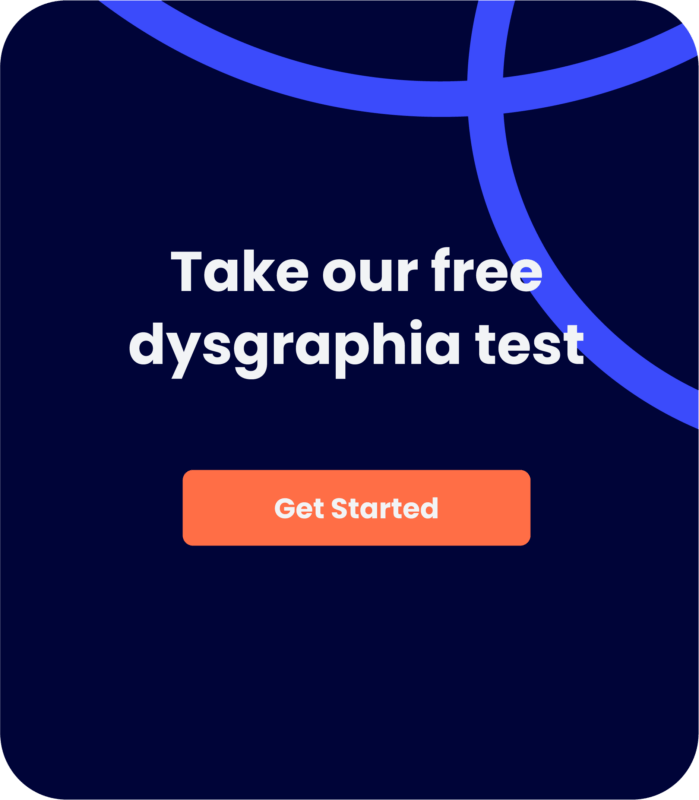What is Dysgraphia?
Dysgraphia is a brain based condition that causes trouble with writing and spelling. Dysgraphia is often overlooked or attributed to laziness, lack of motivation, carelessness, or delayed visual and motor processing (Berninger and Wolf, 2009). According to Berninger and Wolf (2009), a diagnosis of dysgraphia is made when the student exhibits “a cluster”, but not necessarily all, of the symptoms below.
Dysgraphia Symptoms & Signs
- Cramping of fingers and/or pain while writing short entries
- Odd wrist, arm, body, or paper orientations such as bending an arm into an L shape
- Excessive erasures
- Mixed uppercase and lowercase letters
- Inconsistent form and size of letters, or unfinished letters
- Misuse of lines and margins
- Inefficient speed of copying
- Inattentiveness to details when writing
- Frequent need of verbal cues
- Relying heavily on vision to write (e.g., needing to copy rather than formulate)
- Poor legibility
- Handwriting patterns that interfere with spelling and written composition
- Difficulty translating ideas to writing, possibly including difficulty with word-finding
How are Dysgraphia and Dyslexia Different?
Dyslexia and dysgraphia are both language-based learning disorders. While dyslexia mainly affects reading, dysgraphia mainly affects writing. Dyslexia and dysgraphia often occur together and some of their symptoms overlap. For example, spelling difficulties are common in both dyslexia and dysgraphia. In addition, in both dyslexia and dysgraphia there is a stark difference between what the student can understand and express orally and what they can understand and express in writing. However, dyslexia and dysgraphia are different disorders. Here are some symptoms specific to each:

Dysgraphia handwriting sample
Dysgraphia Symptoms
- Difficulty with forming letters consistently and legibly
- Difficulty with spacing letters and words
- Difficulty using upper and lowercase letters appropriately
- Labored, slow writing
- Complaints about hand discomfort and/or fatigue when writing
Dyslexia Symptoms
- Difficulty reading single words accurately
- Difficulty with sounding out and/or pronouncing unfamiliar words
- Avoidance of reading and especially avoidance of reading aloud
- Labored, slow reading
- Complaints about fatigue when reading
About Our Dysgraphia Test
Individual assessment should begin with a clear description of the student’s difficulties, with as much descriptive data as possible and using a writing sample that, as closely as possible, replicates naturalistic (e.g., classroom) demands. This type of focused description may lead to additional assessments, including standardized assessments (e.g., of spelling, copying speed, etc.). It is important to use a range of tools when evaluating for dysgraphia because of the overlap between dysgraphia and dyslexia and because writing involves so many different types of skills. Areas assessed in a dysgraphia evaluation include:
- Letter formation and spacing
- Spelling
- Sentence formulation
- Sentence conventions (e.g., punctuation, capitalization)
- Discourse formulation (specific writing tasks)
- Production of specific written products (quality and speed)
- The cognitive and linguistic abilities that support language-based learning (e.g., vocabulary, working memory, executive function, speech sound awareness and memory, retrieval fluency)
A Script Approach for Dysgraphics
Writers need to automate the transcription process so they can devote their attention to the content of their message. Persistent difficulties with letter formation (reversals, size and spacing issues, misuse of uppercase versus lowercase) can disrupt a writer so much that they can not formulate a written message similar in quality to one they could formulate orally. Writers need a transcription method that does not get in the way of their message. Adult writers tend to develop this kind of transcription. No matter what handwriting method they were taught, adults tend to modify their handwriting into a fast, efficient, personal script. There is a good argument for teaching this kind of legible, fast personal script from the very beginning. It is important to note that script is not the same thing as cursive. Script is not a homogenized, one-size-fits-all, prescribed type of handwriting. Rather, it is more like a dance or a sport. There are principles of form and efficiency, but the execution is always personal. Real Spelling described this script approach as the index finger-driven “dance of the pen.”
The Lexercise Structured Literacy Curriculum™ is a multisensory, explicit approach to mastering the foundations of literacy, including research-backed procedures for teaching and practicing letter writing, along with speech sound awareness, phonics, word analysis, spelling, vocabulary, comprehension, and sentence writing. This approach is consistent with recent neuroscience that supports the connection between letter-sound learning and handwriting. Students learn to write each lowercase letter using a consistent, smooth, and automatic movement pathway, which helps the brain overcome difficulties with letter reversals. This approach to letter formation feels a bit like doing art, and students who have resisted handwriting practice in the past often find they enjoy it!

Lexercise letter formation instruction for the letter “a”
Dysgraphia Treatment
Treatment for dysgraphia should be customized based on a student’s age, symptoms and other individualized factors. During treatment, a qualified structured literacy therapist will isolate the many discrete skills required to write effectively, then teach those skills one by one so students are not overwhelmed or frustrated by the complexity.
Consider the many different strands students hold in mind while writing: the images of letter symbols, the movement path needed to fluently form each letter, the speech sounds they represent, and how the letters must be sequenced to spell the word they have in mind. Beyond that, they must hold in mind the sentence they intend to write, as well as the organization and overall purpose of their writing product. Therapists begin by teaching each of these skills in isolation, then as a skill is practiced and becomes more automatic, a therapist will weave multiple skills together in increasingly complex tasks. The goal is for the student to master the basics of the writing process, using attractive, accurate, efficient, and relaxed handwriting.
Qualified therapists should be trained in the use of both structured literacy methods and dysgraphia-specific methods. In addition, results are best when therapy is provided one-on-one so that treatment can be fully customized for individual needs. Finally, research shows that regular practice with feedback and coaching is essential and should be a part of any rigorous dysgraphia intervention program. The Lexercise Educational Games included in the Lexercise Structured Literacy Curriculum™ accomplish this in only 15 minutes of practice per day.


